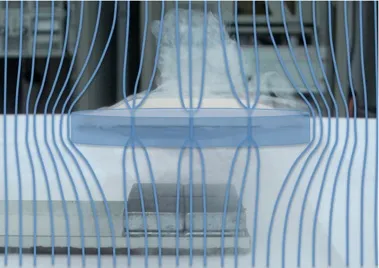The small puck-shaped plate that you can see hovering in mid-air is coated with a special material – known as yttrium barium – which acts as a superconductor when cooled to -196 degrees Celcius.
Superconductorsbehave strangely when they get close to magnets – like the ones sitting below the plate in the video. The superconductor forces out the magnetic field created by the magnets around it – this is known as the Meissner effect.
In the case of this demonstration the superconductor is so thin that some of the field is able to pass
the plate at its weakest points.

The flux tubes stop before reaching the core of the superconductor
The spots where the field passes through are known as “magnetic flux tubes”. They exist at the thinnest areas of the plate and become trapped. These trapped tubes effectively lock it in place making it levitate and stay at a fixed position.
Credit:ASTC/Tel-Aviv University
Follow Science Focus onTwitter,Facebook, Instagramand Flipboard
